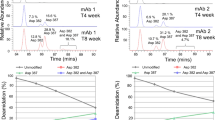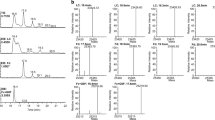Abstract
Purpose
To determine the relative importance of direct hydrolysis and β-elimination, two common mechanisms of antibody hinge region fragmentation, and the impact of the conserved N-linked oligosaccharides in affecting antibody fragmentation under various pH.
Methods
A recombinant monoclonal antibody was incubated in buffers of various pH at 40°C for 5 weeks. The level of fragmentation was measured using size-exclusion-chromatography (SEC). The specific sites of fragmentation were determined by analyzing SEC fractions using liquid chromatography mass spectrometry (LC-MS).
Results
Direct hydrolysis was accelerated by acidic and basic pH, while β-elimination contributed to hinge region fragmentation at pH 7 and above. In addition, a shift of the major peptide bond hydrolysis sites in the hinge region towards the C-terminal direction with the decrease of sample pH from 9 to 5 was observed. At pH 4, the major cleavage site shifted outside the hinge region and was localized in the CH2 domain. Oligosaccharides did not affect hinge region fragmentation in the pH range of 5–9, however, at pH 4 oligosaccharides slowed down fragmentation in the CH2 domain.
Conclusions
Antibody fragmentation level, sites and mechanisms were affected by pH. Oligosaccharides only affected the rate of fragmentation at pH 4.







Similar content being viewed by others
References
A. J. Gearing, S. J. Thorpe, K. Miller, M. Mangan, P. G. Varley, T. Dudgeon, G. Ward, C. Turner, and R. Thorpe. Selective cleavage of human IgG by the matrix metalloproteinases, matrilysin and stromelysin. Immunol. Lett. 81:41–48 (2002).
G. E. Connell, and R. H. Painter. Fragmentation of immunoglobulin during storage. Can. J. Biochem. 44:371–379 (1966).
Y. Kong, Y. B. Chung, S. Y. Cho, and S. Y. Kang. Cleavage of immunoglobulin G by excretory-secretory cathepsin S-like protease of Spirometra mansoni plerocercoid. Parasitology. 109:611–621 (1994).
A. M. Smith, A. J. Dowd, M. Heffernan, C. D. Robertson, and J. P. Dalton. Fasciola hepatica: a secreted cathepsin L-like proteinase cleaves host immunoglobulin. Int. J. Parasitol. 23:977–983 (1993).
P. Berasain, C. Carmona, B. Frangione, J. P. Dalton, and F. Goni. Fasciola hepatica: parasite-secreted proteinases degrade all human IgG subclasses: determination of the specific cleavage sites and identification of the immunoglobulin fragments produced. Exp. Parasitol. 94:99–110 (2000).
H. S. Gadgil, P. V. Bondarenko, G. D. Pipes, T. M. Dillon, D. Banks, J. Abel, G. R. Kleemann, and M. J. Treuheit. Identification of cysteinylation of a free cysteine in the Fab region of a recombinant monoclonal IgG1 antibody using Lys-C limited proteolysis coupled with LC/MS analysis. Anal. Biochem. 355:165–174 (2006).
A. J. Cordoba, B. J. Shyong, D. Breen, and R. J. Harris. Non-enzymatic hinge region fragmentation of antibodies in solution. J. Chromatogr. B Analyt. Technol. Biomed. Life Sci. 818:115–121 (2005).
P. E. Rao and D. J. Kroon. Orthoclone OKT3. Chemical mechanisms and functional effects of degradation of a therapeutic monoclonal antibody. In Y. J. Wang and R. Pearlman (eds.), Stability and characterization of Protein and Peptide Drugs: Case Histories, Plenum Press, New York, 1993, pp. 135–158.
W. Jiskoot, E. C. Beuvery, A. A. de Koning, J. N. Herron, and D. J. Crommelin. Analytical approaches to the study of monoclonal antibody stability. Pharm. Res. 7:1234–1241 (1990).
M. Paborji, N. L. Pochopin, W. P. Coppola, and J. B. Bogardus. Chemical and physical stability of chimeric L6, a mouse–human monoclonal antibody. Pharm. Res. 11:764–771 (1994).
A. J. Alexander, and D. E. Hughes. Monitoring of IgG antibody thermal stability by micellar electrokinetic capillary chromatography and matrix-assisted laser desorption/ionization mass spectrometry. Anal. Chem. 67:3626–3632 (1995).
A. Usami, A. Ohtsu, S. Takahama, and T. Fujii. The effect of pH, hydrogen peroxide and temperature on the stability of human monoclonal antibody. J. Pharm. Biomed. Anal. 14:1133–1140 (1996).
H. Liu, G. Gaza-Bulseco, and J. Sun. Characterization of the stability of a fully human monoclonal IgG after prolonged incubation at elevated temperature. J. Chromatogr. B. Analyt. Technol. Biomed. Life Sci. 837:35–43 (2006).
T. M. Dillon, P. V. Bondarenko, and M. Speed Ricci. Development of an analytical reversed-phase high-performance liquid chromatography-electrospray ionization mass spectrometry method for characterization of recombinant antibodies. J. Chromatogr. A. 1053:299–305 (2004).
T. M. Dillon, P. V. Bondarenko, D. S. Rehder, G. D. Pipes, G. R. Kleemann, and M. S. Ricci. Optimization of a reversed-phase high-performance liquid chromatography/mass spectrometry method for characterizing recombinant antibody heterogeneity and stability. J. Chromatogr. A. 1120:112–120 (2006).
S. L. Cohen, C. Price, and J. Vlasak. Beta-elimination and peptide bond hydrolysis: two distinct mechanisms of human IgG1 hinge fragmentation upon storage. J. Am. Chem. Soc. 129:6976–6977 (2007).
A. S. Nashef, D. T. Osuga, H. S. Lee, A. I. Ahmed, J. R. Whitaker, and R. E. Feeney. Effects of alkali on proteins. Disulfides and their products. J. Agric. Food Chem. 25:245–51 (1977).
T. M. Florence. Degradation of protein disulphide bonds in dilute alkali. Biochem. J. 189:507–520 (1980).
A. K. Galande, J. O. Trent, and A. F. Spatola. Understanding base-assisted desulfurization using a variety of disulfide-bridged peptides. Biopolymers. 71:534–551 (2003).
T. Xiang, E. Lundell, Z. Sun, and H. Liu. Structural effect of a recombinant monoclonal antibody on hinge region peptide bond hydrolysis. J. Chromatogr. B. Analyt. Technol. Biomed. Life Sci. 858:254–262 (2007).
T. Geiger, and S. Clarke. Deamidation, isomerization, and racemization at asparaginyl and aspartyl residues in peptides. Succinimide-linked reactions that contribute to protein degradation. J. Biol. Chem. 262:785–794 (1987).
M. Kats, P. C. Richberg, and D. E. Hughes. pH-dependent isoform transitions of a monoclonal antibody monitored by micellar electrokinetic capillary chromatography. Anal. Chem. 69:338–343 (1997).
Z. I. Kravchuk, A. P. Vlasov, G. V. Liakhnovich, and S. P. Martsev. A stable conformer of IgG, prepared by an acidic influence: study by calorimetry, binding of the C1q complement component, and monospecific anti-IgG. Biokhimiia. 59:1458–77 (1994).
S. P. Martsev, Z. I. Kravchuk, and A. P. Vlasov. Large increase in thermal stability of the CH2 domain of rabbit IgG after acid treatment as evidenced by differential scanning calorimetry. Immunol. Lett. 43:149–152 (1994).
S. P. Martsev, Z. I. Kravchuk, A. P. Vlasov, and G. V. Lyakhnovich. Thermodynamic and functional characterization of a stable IgG conformer obtained by renaturation from a partially structured low pH-induced state. FEBS Lett. 361:173–175 (1995).
M. H. Tao, and S. L. Morrison. Studies of aglycosylated chimeric mouse–human IgG. Role of carbohydrate in the structure and effector functions mediated by the human IgG constant region. J. Immunol. 143:2595–2601 (1989).
J. Lund, T. Tanaka, N. Takahashi, G. Sarmay, Y. Arata, and R. Jefferis. A protein structural change in aglycosylated IgG3 correlates with loss of huFc gamma R1 and huFc gamma R111 binding and/or activation. Mol. Immunol. 27:1145–1153 (1990).
H. Matsuda, S. Nakamura, Y. Ichikawa, K. Kozai, R. Takano, M. Nose, S. Endo, Y. Nishimura, and Y. Arata. Proton nuclear magnetic resonance studies of the structure of the Fc fragment of human immunoglobulin G1: comparisons of native and recombinant proteins. Mol. Immunol. 27:571–579 (1990).
Y. Mimura, S. Church, R. Ghirlando, P. R. Ashton, S. Dong, M. Goodall, J. Lund, and R. Jefferis. The influence of glycosylation on the thermal stability and effector function expression of human IgG1-Fc: properties of a series of truncated glycoforms. Mol. Immunol. 37:697–706 (2000).
H. Liu, G. G. Bulseco, and J. Sun. Effect of posttranslational modifications on the thermal stability of a recombinant monoclonal antibody. Immunol. Lett. 106:144–153 (2006).
H. Liu, G. Gaza-Bulseco, T. Xiang, and C. Chumsae. Structural effect of deglycosylation and methionine oxidation on a recombinant monoclonal antibody. Mol. Immunol. 45:701–708 (2008).
Author information
Authors and Affiliations
Corresponding author
Rights and permissions
About this article
Cite this article
Gaza-Bulseco, G., Liu, H. Fragmentation of a Recombinant Monoclonal Antibody at Various pH. Pharm Res 25, 1881–1890 (2008). https://doi.org/10.1007/s11095-008-9606-3
Received:
Accepted:
Published:
Issue Date:
DOI: https://doi.org/10.1007/s11095-008-9606-3




